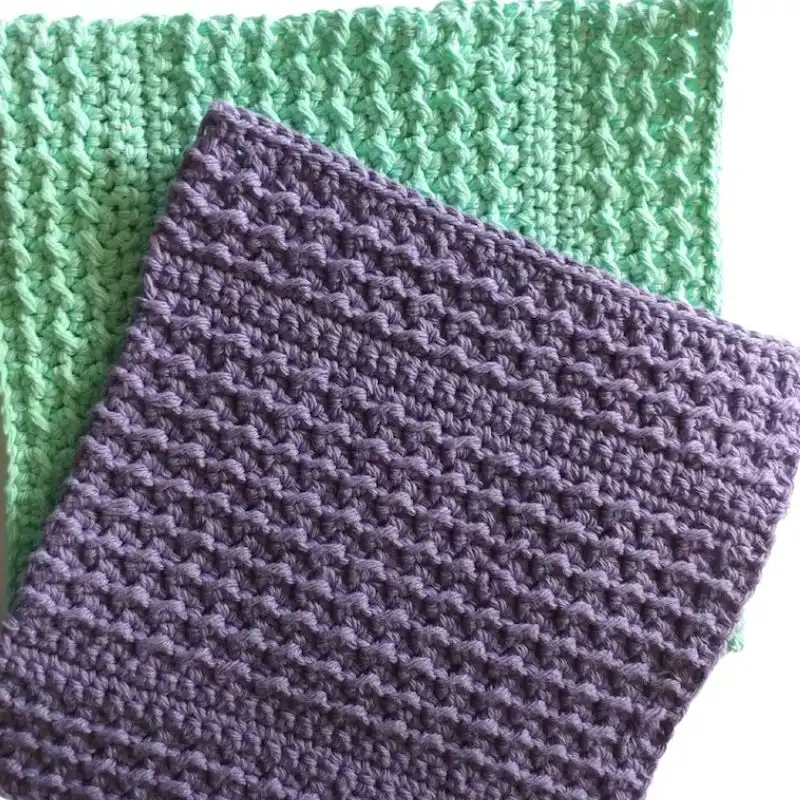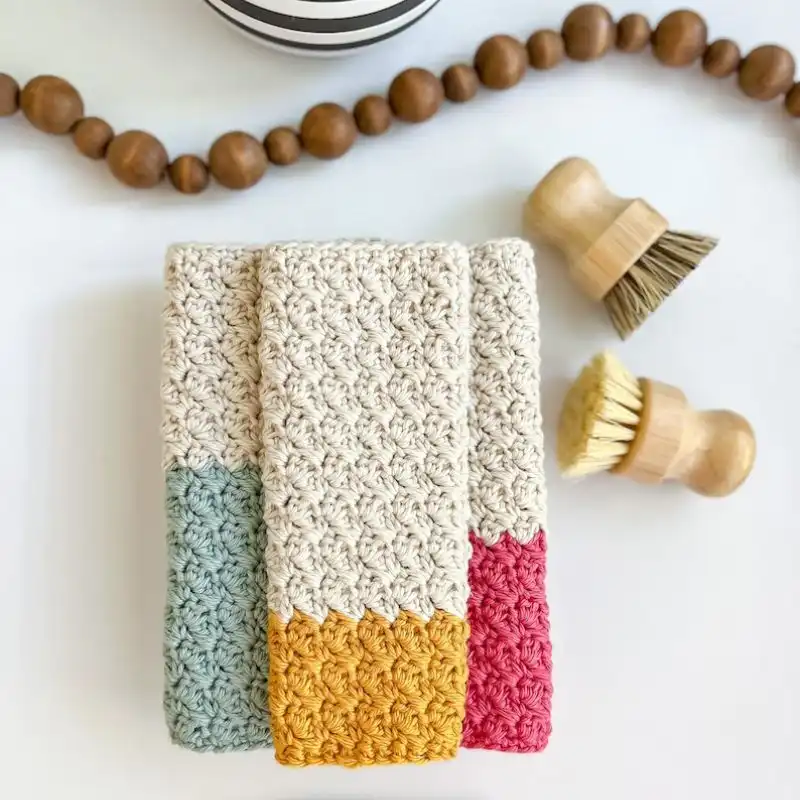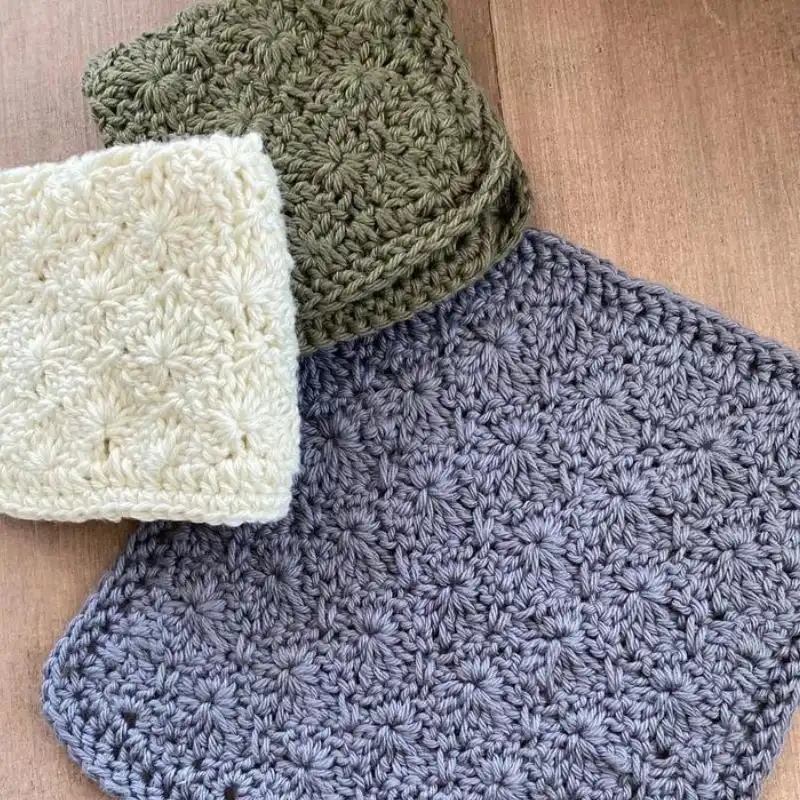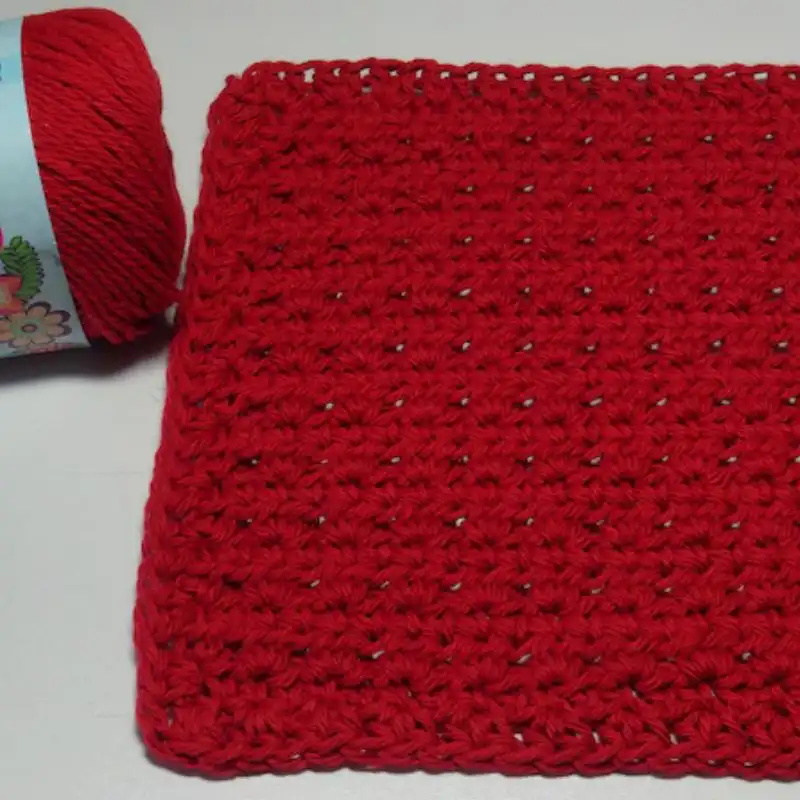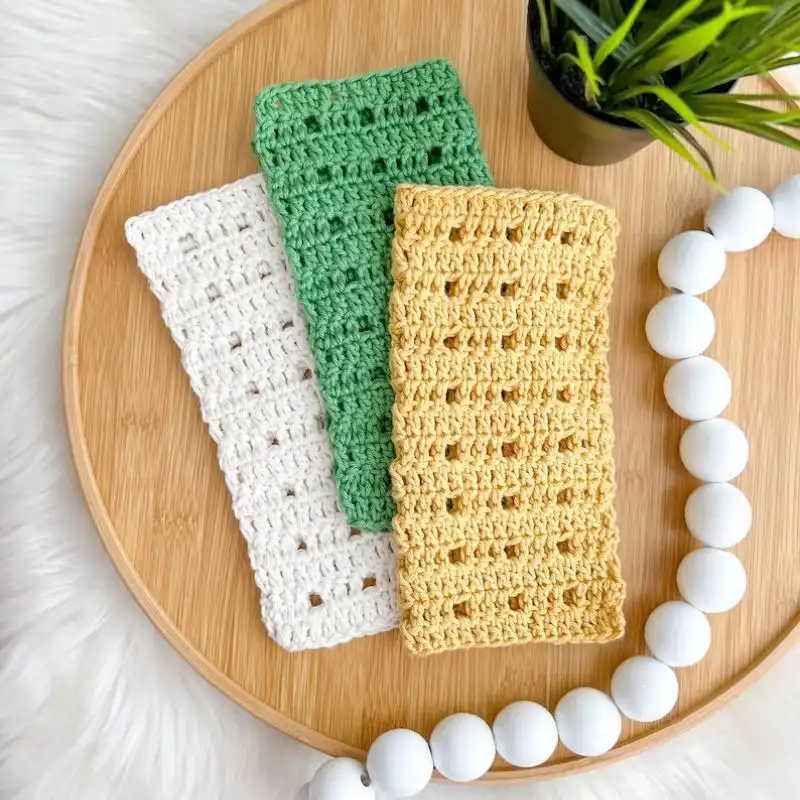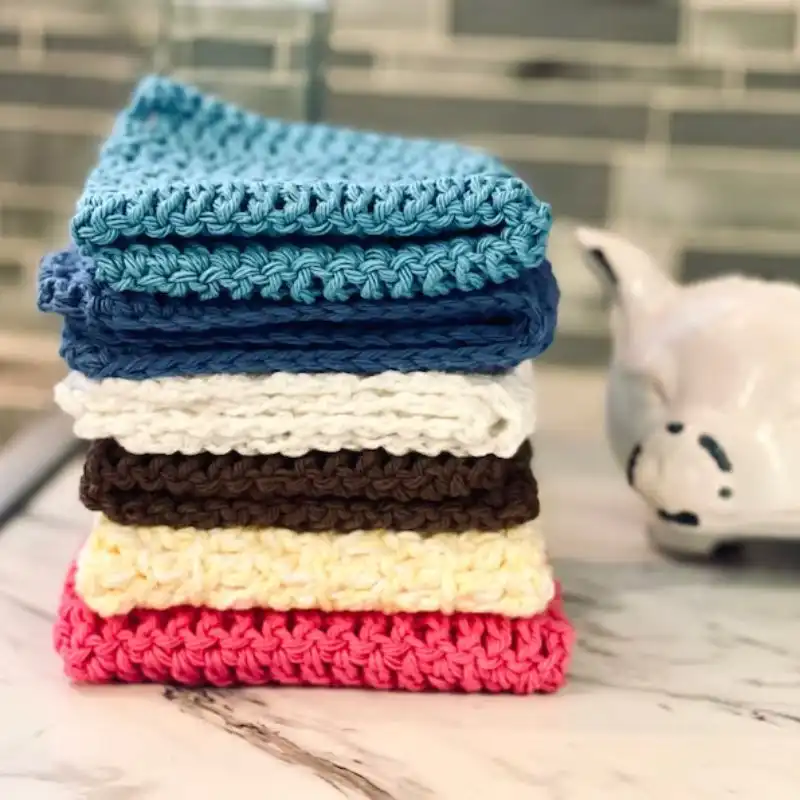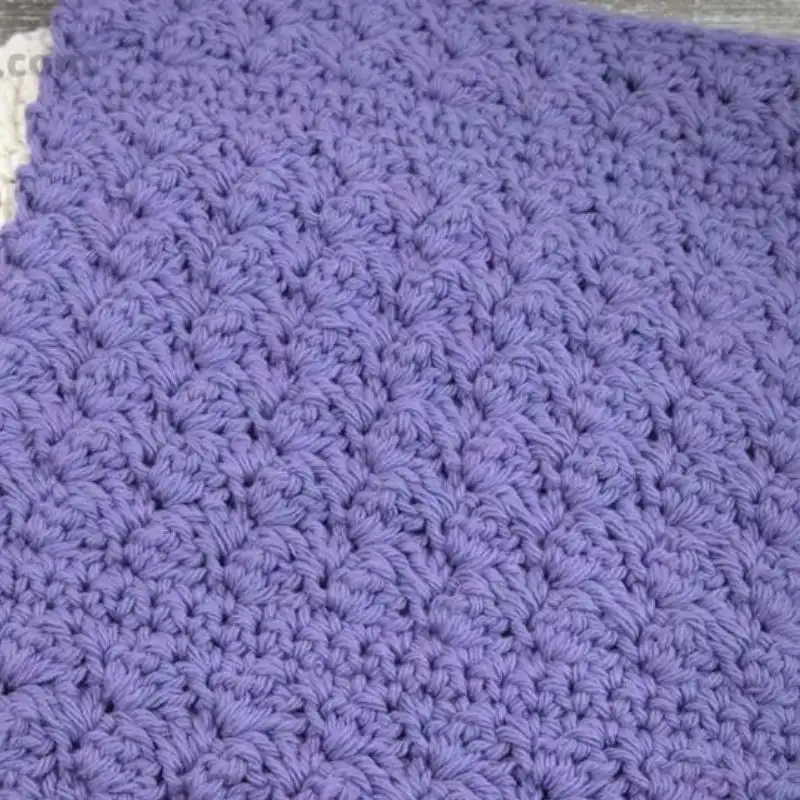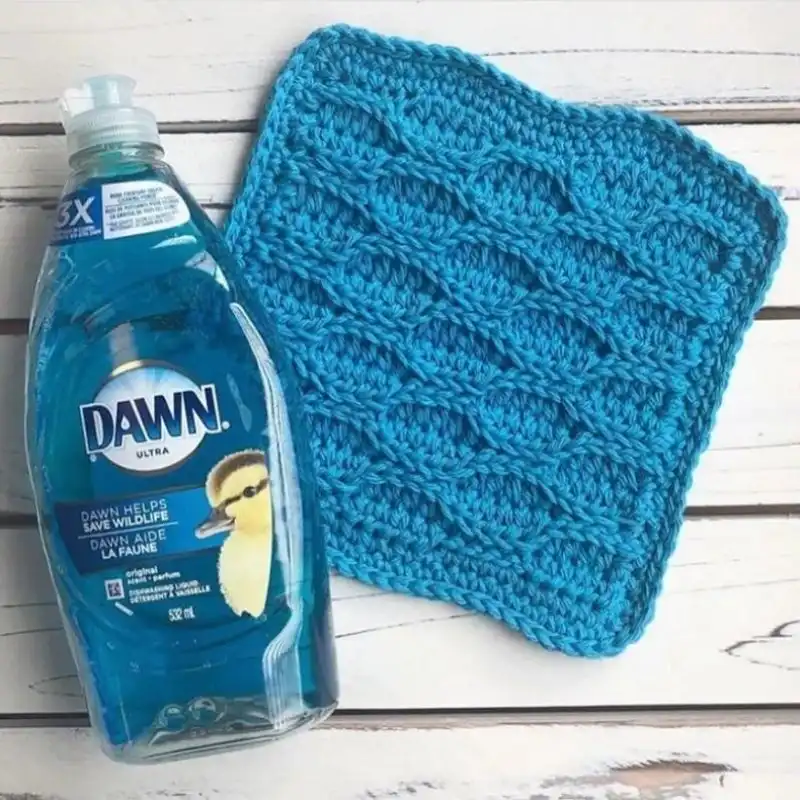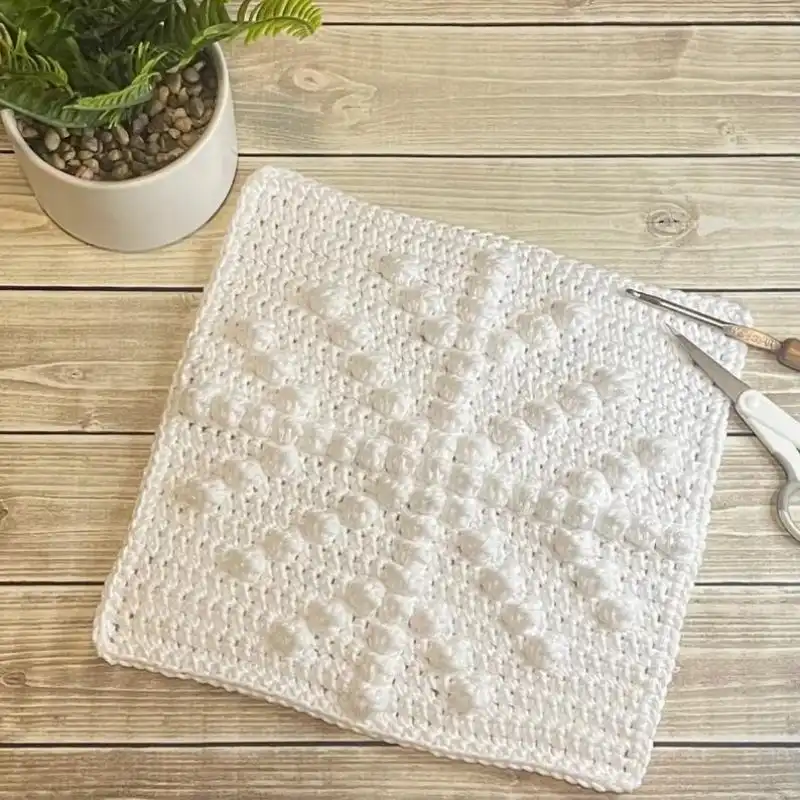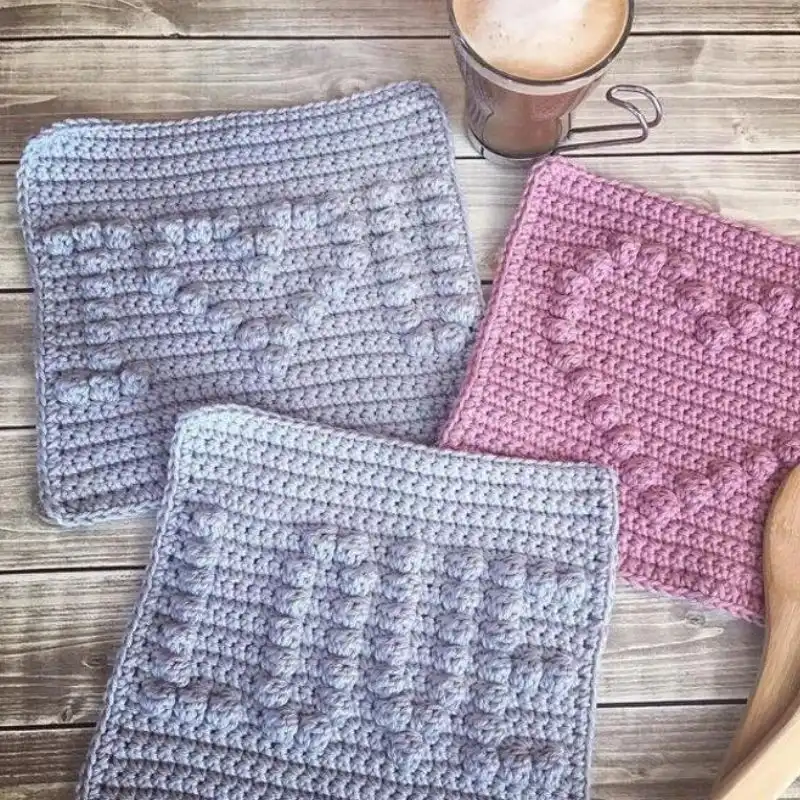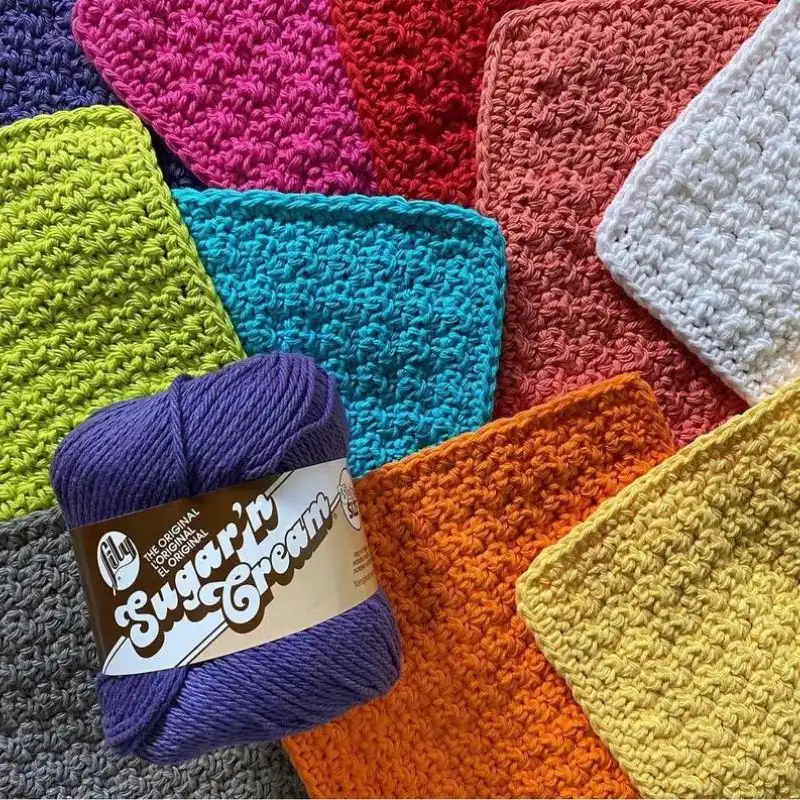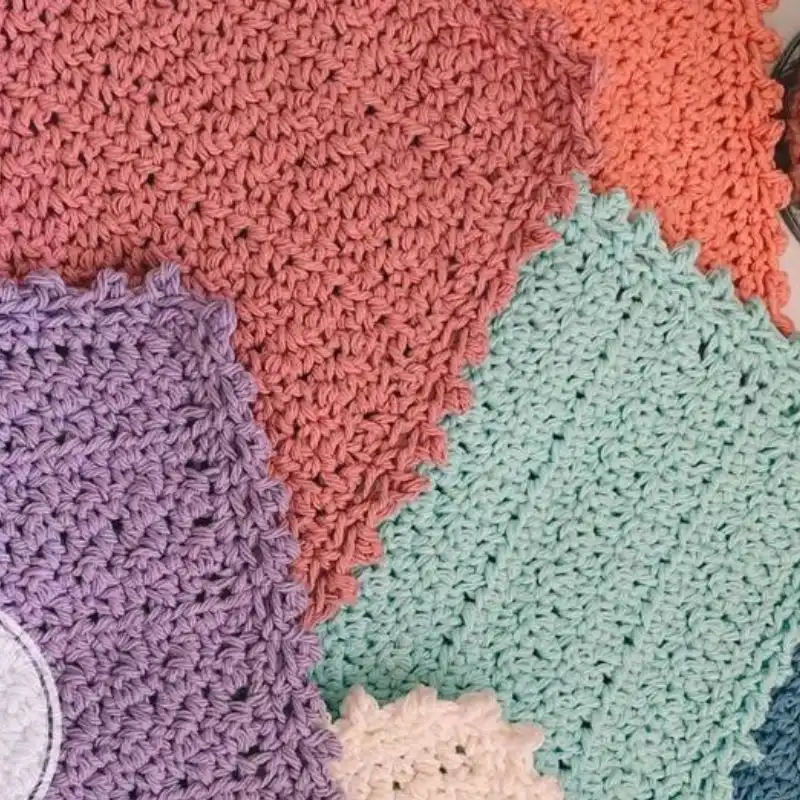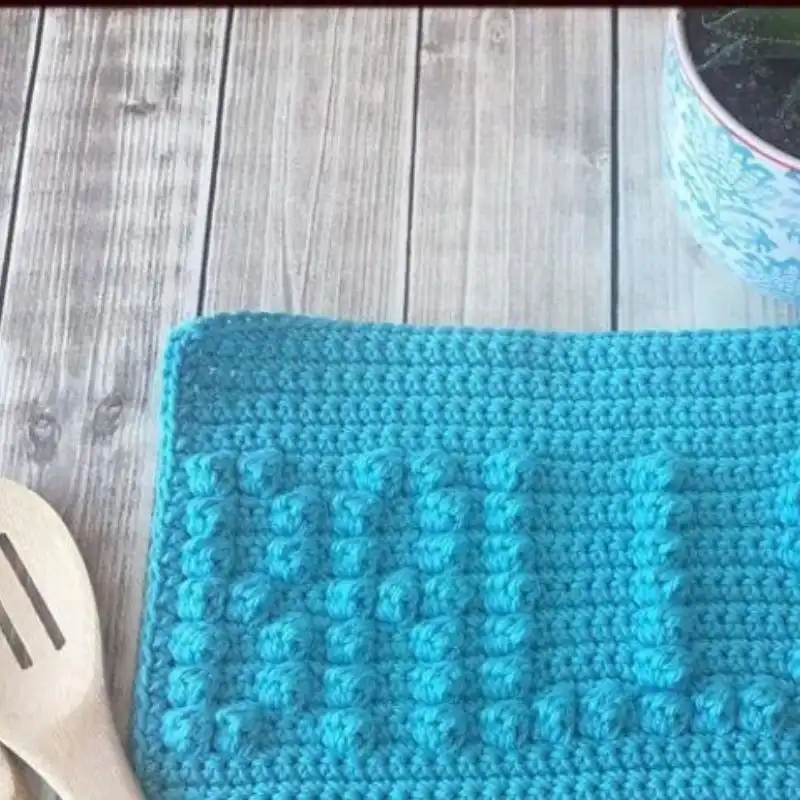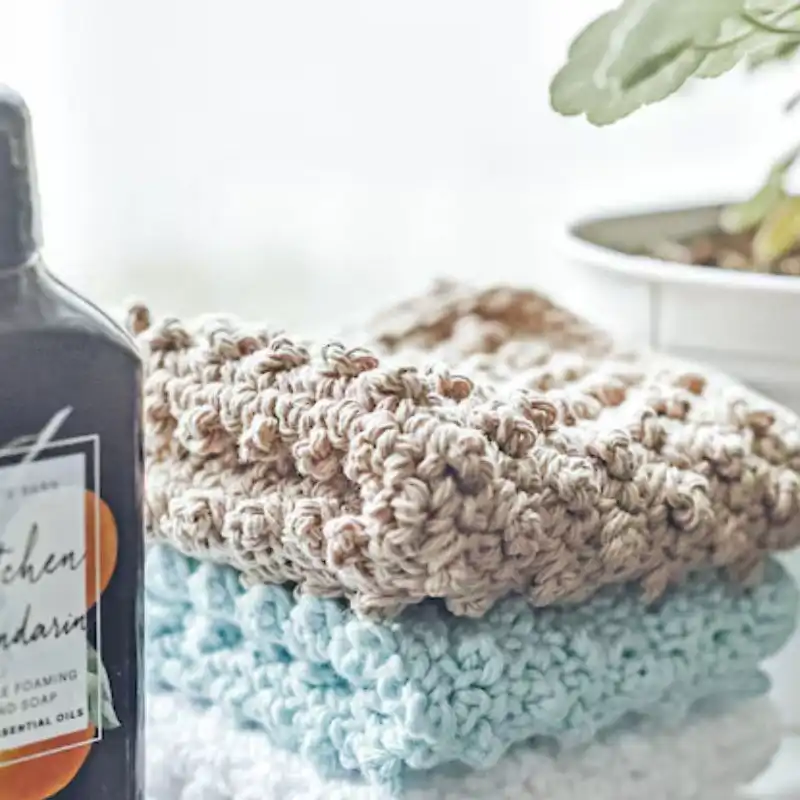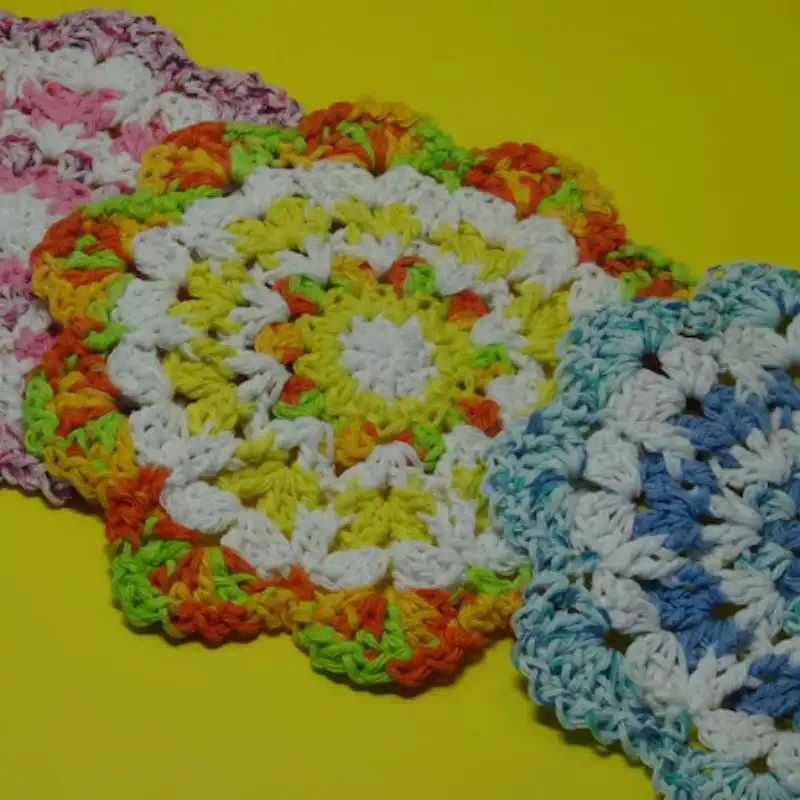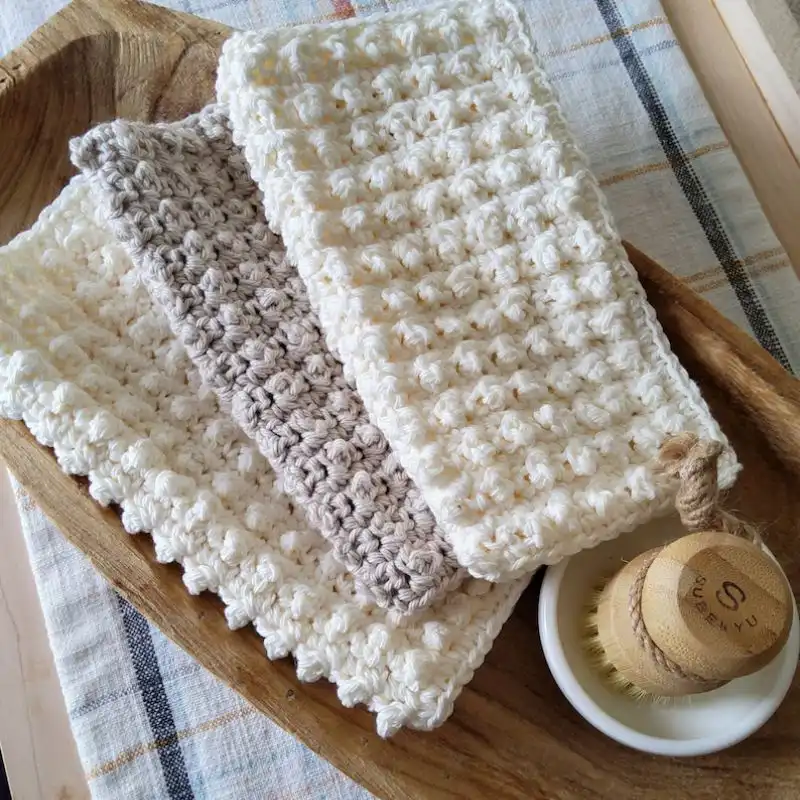Crochet dishcloth patterns offer a unique blend of practicality and creativity. A handmade touch in the kitchen is always a great idea when in doubt. Yet, many overlook the versatility and durability of crocheted dishcloths.

Not only do they add a homemade charm to your kitchen, but they are also highly effective for daily chores. If you need help with how to begin, don’t worry.
My best advice is to start with simple, easy-to-follow patterns. These designs are great for both beginners and seasoned crafters.
Whereas store-bought dishcloths wear out quickly, crocheted ones last longer, making them a wise choice. In fact, with the correct pattern and technique, you can create beautiful and functional dishcloths that elevate your daily routine.
What Is The Best Yarn For Making Dishcloths?
The best yarn for making dishcloths is typically cotton yarn. Cotton is an excellent choice because it is durable, absorbent, and withstand frequent washing.
Choosing a medium-weight cotton yarn is a good idea, as it is thick enough to be absorbent yet not too bulky for intricate crochet patterns. When in doubt, 100% cotton yarn is often recommended for its natural properties and ease of care.
Remember, it is better to avoid synthetic yarns for dishcloths, as they are less absorbent and not as durable when exposed to kitchen use.
Homemade dishcloths made with quality cotton yarn can be practical and beautiful additions to your kitchen. If you’re unsure which brand or type to choose, my best advice is to look for yarns labeled as ‘kitchen cotton’ or ‘dishcloth cotton’ for optimal results.
Is It Worth To Crochet Dishcloth Pattern?
Yes, it is worth it to crochet dishcloth patterns. Crocheting dishcloths are fabulous for several reasons. First, it allows for creative expression.
You can choose from various patterns and colors, making each dishcloth unique. Homemade dishcloths add a personal touch to your kitchen or make thoughtful gifts.
Moreover, crocheted dishcloths are durable and reusable, making them an eco-friendly choice. They can be more absorbent and last longer than store-bought ones, especially with high-quality cotton yarn.
When in doubt about the environmental impact of kitchenware, turning to sustainable options like crocheted dishcloths is a good idea.
Additionally, crocheting can be a relaxing and rewarding hobby. It’s a way to unwind and focus on a simple, productive task. If you need more time in a new skill, remember that crocheting dishcloths can be a great starting point for beginners due to their simplicity and practicality.
Popular Stitches To Crochet Dishcloth Patterns
- Single Crochet Stitch: This basic stitch is excellent for beginners. It creates a tight, dense fabric that’s good for scrubbing.
- Half Double Crochet Stitch: This stitch is slightly taller than the single Crochet, providing a nice texture and thickness, ideal for dishcloths.
- Double Crochet Stitch: It works quickly and creates a softer, more flexible fabric for wiping surfaces.
- Shell Stitch: This decorative stitch creates a pretty scalloped edge, adding an aesthetic touch to your dishcloths while still being functional.
- Waffle Stitch: Known for its texture, the waffle stitch is excellent for dishcloths as it provides a scrubbing surface and is highly absorbent.
- Basketweave Stitch: This stitch creates a thick, woven texture that’s durable and effective for kitchen use.
- Moss Stitch (or Linen Stitch): This stitch creates a dense fabric with a beautiful, delicate texture, perfect for dishcloths that must be tough and gentle.
- Herringbone Half Double Crochet Stitch: This stitch offers a unique diagonal texture that’s visually appealing and good for scrubbing.
- Corner-to-Corner (C2C) Stitch: While a bit more advanced, this stitch creates a diagonal, tiled texture, ideal for more intricate dishcloth designs.
How Long Should A Crochet Dishcloth Pattern Be?
The size of a crochet dishcloth pattern can vary, but typically, a good size for a dishcloth is about 8 to 12 inches square. This size is great for both usability and ease of crocheting.
An 8-inch square dishcloth is compact and great for everyday kitchen tasks. In contrast, a 12-inch square provides more surface area for extensive cleanups. A size within this range usually works well for most purposes when in doubt.
The size of your dishcloth can also depend on the stitch pattern you choose. Some stitches may require adjustments in the starting chain to achieve the desired size. Remember to consider the yarn weight and hook size, as they can affect the overall size of your finished dishcloth.
If you need help deciding what size to make, starting with a standard 8-inch square is better, as it’s universally functional. You can constantly adjust the dimensions for a homemade, custom feel to suit your personal preference or specific needs.
Essential Tools & Materials
- Yarn: Cotton yarn is the best choice for dishcloths. It’s absorbent, durable, and machine washable. Look for medium-weight (worsted) cotton yarn for the best results.
- Crochet Hook: The hook size can vary depending on the yarn and the desired tightness of your stitches. A good idea to start with is a hook size recommended on the yarn label, often around sizes H (5.0mm) to J (6.0mm) for worsted-weight yarn.
- Scissors: A sharp pair of scissors is essential for cutting your yarn when you finish a dishcloth or need to change colors.
- Yarn Needle: This is great for weaving in ends once your dishcloth is completed. A yarn needle with a large eye is best for working with thicker yarns.
- Measuring Tape: Useful for checking the size of your dishcloth as you work, ensuring you’re staying consistent with your desired dimensions.
- Stitch Markers: These can help mark certain stitches or rows, especially if you’re following a more complex pattern.
- Pattern: Following a pattern is essential, especially if you’re new to crocheting, whether it’s a written pattern or a diagram.
- Notepad and Pen: It is a good idea to keep a notepad and pen handy to make notes or keep track of your rows and stitches.
Abbreviations Of Common Crochet Stitches And Techniques
- ch – Chain
- sc – Single Crochet
- hdc – Half Double Crochet
- dc – Double Crochet
- tr – Treble Crochet (or Triple Crochet)
- sl st – Slip Stitch
- st(s) – Stitch(es)
- sk – Skip
- yo – Yarn Over
- sp(s) – Space(s)
- Inc – Increase (add one or more stitches)
- Dec – Decrease (eliminate one or more stitches)
- blo – Back Loop Only
- flo – Front Loop Only
- tog – Together (used to indicate stitches worked together, as in a decrease)
- rep – Repeat
- rnd – Round
- fp – Front Post (as in front post double crochet, fpdc)
- bp – Back Post (as in back post double Crochet, bpdc)
- [] – Work instructions within brackets as many times as directed
- () – Work instructions within parentheses in the same stitch or space
How To Understand Dishcloth Crochet Stitches & Techniques?
- Learn Basic Stitches: Start with the basic stitches like single Crochet (sc), double Crochet (dc), and half double Crochet (hdc). These form the foundation of most crochet patterns. Practice making these stitches until you feel comfortable with them.
- Read Patterns: Crochet patterns use standard abbreviations (like ch for chain, sl st for slip stitch, etc.). Familiarize yourself with these abbreviations. When in doubt, refer to a crochet dictionary or online resources.
- Follow Tutorials: Visual learning is excellent for Crochet. Look for video tutorials online, especially for specific dishcloth patterns or stitches. They can guide you step-by-step through the process.
- Practice Consistent Tension: The tension of your yarn determines the tightness of your stitches. Consistent tension is critical for even neat stitches. This comes with practice, so remember to keep trying, even if it initially feels awkward.
- Understand Gauge: Gauge refers to the number of stitches per inch. Gauge is less critical for dishcloths than for garments. However, understanding it’s still a good idea, especially if you follow a specific pattern.
- Learn Finishing Techniques: Techniques like weaving in ends and blocking are essential for the finished look of your dishcloth. Blocking is when you wet the finished dishcloth and lay it out to dry in the proper shape.
- Experiment with Textures and Patterns: Try different stitch patterns and textures once you’re comfortable with the basics. Some stitches are better for scrubbing, while others are more decorative.
- Ask for Help: If unsure about a technique or a pattern, feel free to ask for help. Joining a crochet group or community, either locally or online, can be very beneficial.
- Practice Makes Perfect: The best advice I can give is to practice. The more you crochet, the more familiar you’ll become with different stitches and techniques.
RELATED: 49 Fun Unicorn Crochet Patterns For Whimsical Wonders
Which Yarn Is Best For A Crochet Dishcloth Pattern?
- Absorbency: Cotton is highly absorbent, making it perfect for kitchen use where soaking up water and spills is common.
- Durability: It holds up well to frequent use and washing, essential for an item like a dishcloth that undergoes a lot of wear and tear.
- Non-abrasive: Cotton is gentle on surfaces so it won’t scratch dishes, countertops, or appliances.
- Machine Washable: Cotton dishcloths can be easily cleaned in a washing machine, an essential consideration for kitchen hygiene.
- Texture: Cotton has a nice texture that can create scrubbing power in a dishcloth, depending on the stitch pattern.
How Much Yarn Do I Need To Crochet Dishcloth Pattern?
The amount of yarn needed to crochet a dishcloth pattern varies depending on several factors, including the size, the stitch pattern used, the yarn weight, and the crochet hook size. However, as a general guideline, a standard-sized dishcloth (about 8 to 12 inches square) typically requires about 50 to 100 yards of medium-weight (worsted) cotton yarn.
- Dishcloth Size: A smaller dishcloth will use less yarn. For a standard 8-inch square, you might use closer to 50 yards, while a larger 12-inch dishcloth might require closer to 100 yards.
- Stitch Pattern: Some stitch patterns use more yarn than others. For example, denser stitches like single Crochet consume more yarn, whereas lacy or openwork patterns may use less.
- Yarn Weight: Thicker yarns (like bulky or chunky) require more yardage to complete a dishcloth of a given size than thinner yarns (like sport or DK weight).
- Crochet Hook Size: Larger hooks produce looser stitches and can use slightly less yarn, while smaller hooks create tighter stitches and can use more yarn.
Is It Beginner Friendly?
- Simple Patterns: Many dishcloth patterns use basic stitches like single Crochet (sc), double Crochet (dc), or a combination of both, which are easy for beginners to learn and master.
- Trim Size: Dishcloths are relatively small projects that don’t require much time or yarn. This makes them more manageable for beginners than larger projects like blankets or sweaters.
- Quick Results: Because of their size, dishcloths can be completed relatively quickly, providing instant gratification and a sense of accomplishment.
- Practical Application: Unlike some projects that might end up stored away, dishcloths are practical and can be used daily in your kitchen. This adds a sense of purpose to your crafting.
- Skill Development: Making dishcloths allows you to practice and reinforce basic crocheting techniques, such as maintaining even tension, creating consistent stitches, and following patterns.
- Experimentation: Dishcloths allow you to experiment with different stitches and patterns without a significant commitment of resources. This can help build your confidence and skills.
How To Crochet A Basic Beginner-Friendly Dishcloth Pattern?
Materials Needed
- Medium-weight (worsted) cotton yarn
- Crochet hook (size H/8 or 5mm is a good choice for beginners)
- Scissors
- Yarn needle for weaving in ends
Step-by-Step Guide
- Start with a Slip Knot: Make a slip knot on your crochet hook. This is the first step in most crochet projects.
- Chain Stitches (ch): Chain 27 stitches. This will be the width of your dishcloth. If you want a smaller or larger dishcloth, adjust the number of chains accordingly.
- Single Crochet (sc): Insert the hook into the second chain from the hook. Yarn over and pull up a loop. Yarn over again and pull through both loops on the hook. That’s your first single, Crochet. Continue to single Crochet in each chain across. You will have 26 single crochets.
- Creating Rows: At the end of the row, chain one (this acts as a turning chain), then turn your work.
- Continue Single Crocheting: Insert your hook into the first single Crochet from the previous row, and make a single crochet. Continue single crocheting in each stitch across the row.
- Repeat step 5 until the dishcloth is as long as it is wide, typically about 8 to 10 inches, to form a square. The number of rows will depend on your gauge (how big your stitches are).
- Finishing Off: Once your dishcloth is the desired size, cut the yarn, leaving a tail of a few inches. Yarn over and completely pull through the loop on your hook to secure the end.
- Weave in Ends: Use a yarn needle to weave in the ends back and forth through your work to hide them.
Tips To Avoid Crochet Dishcloth Patterns Mistakes
- Start with a Gauge Swatch: Although gauge is less critical for dishcloths than for garments, a swatch can help you get a feel for your stitches and whether you need to adjust your hook size or tension.
- Count Your Stitches: Regularly count your stitches to ensure you have the same number in each row. This helps maintain the shape of your dishcloth and prevents it from becoming lopsided.
- Keep an Even Tension: Consistent yarn tension is critical to uniform stitches. If you’re too tight or loose, your dishcloth may not lay flat or have an even texture.
- Use Stitch Markers: If your pattern involves turning or has repeating sections, stitch markers can be a great reminder of where you are in the pattern.
- Read Patterns Thoroughly: Before starting, read through the entire pattern to understand it fully. This helps avoid surprises or confusion mid-project.
- Practice New Stitches Before Starting: If your pattern includes unfamiliar stitches, practice them separately before incorporating them into your project.
- Don’t Rush: Take your time, especially if you’re new to crocheting. Rushing can lead to more mistakes.
- Don’t Ignore Mistakes: If you notice a mistake, it’s usually better to undo (frog) your work back to the error and correct it. This practice helps improve your skills.
- Keep Your Edges Straight: Pay special attention to each row’s first and last stitch, as these are familiar places where mistakes happen, causing uneven edges.
- Stay Organized: Keep track of your rows and stitches, especially if interrupted. Noting down where you left off can be helpful.
- Relax Your Hands: Ensure your hands are relaxed while crocheting to avoid strain and to maintain an even tension.
- Seek Help When Needed: Don’t hesitate to ask for help or look up tutorials if you’re stuck. Crochet communities online can be very supportive.
- Enjoy the Process: Remember that making mistakes is a part of learning. Enjoy the process and the unique touch you bring to your handmade items.
29 Different Types Of Dishcloth Patterns
1. Easy Crochet Dishcloth Pattern
This pattern focuses on simple, foundational crochet stitches, perfect for beginners, resulting in a practical and durable dishcloth. It’s great for learning and practicing basic techniques, offering flexibility in terms of size and color. The end product is a versatile and essential kitchen item, ideal for those starting their crochet journey.
2. Moss Stitch Cotton Dish Cloth
Featuring the moss stitch, this pattern creates a dishcloth with a dense, textured surface, excellent for cleaning. It’s both visually appealing and practical, offering a soothing crochet experience. The pattern is ideal for crocheters exploring textures while making a functional kitchen accessory.
Suggested Yarn: Cotton Yarn
Difficulty Level: Intermediate
Yarn Weight: Worsted
Crochet Hook: 5.5 mm (I-9)
3. Simple Crochet Dishcloth
This pattern emphasizes ease and functionality and uses basic stitches for a sturdy and uniform dishcloth. Ideal for beginners, it provides a quick, satisfying project and an introduction to essential crochet skills. This no-frills dishcloth is perfect for daily kitchen use.
Suggested Yarn: Cotton Yarn
Difficulty Level: Intermediate
Yarn Weight: Worsted
Crochet Hook: 5.0 mm (H-8)
4. Farmhouse Dish Cloth
This pattern evokes rustic charm with textured stitches and warm colors. It’s designed for durability and absorbency, adding a touch of homespun elegance to the kitchen. It suits those with basic skills and creates a cozy, country kitchen vibe.
Suggested Yarn: DROPS Muskat - Cotton Worsted
Difficulty Level: Beginner
Yarn Weight: Worsted
Crochet Hook Size: H (5.0 mm)
5. Berry Clean Cloth
Playful and unique, this pattern features berry-like textures for an effective scrubbing surface. It’s visually engaging and ideal for intermediate crocheters looking to try more advanced stitches. The resulting dishcloth is both fun and practical for kitchen use.
Suggested Yarn: Cotton Yarn
Difficulty Level: Intermediate
Yarn Weight: Worsted
Crochet Hook: 5.5 mm (I-9)
6. Easy Beginner Dishcloth
Tailored for beginners, this pattern focuses on simple, repetitive stitches for a straightforward project. It’s perfect for practicing basic crochet techniques, resulting in a functional and rewarding dishcloth. The pattern allows for customization in color, making each creation unique.
7. Modern Crochet Pattern
This contemporary pattern blends style and functionality, featuring minimalist designs and often monochromatic color schemes. Ideal for adding a modern touch to kitchen décor, it’s suitable for various skill levels and results in a chic, practical dishcloth.
Suggested Yarn: Acrylic Yarn
Difficulty Level: Intermediate
Yarn Weight: Light Worsted
Crochet Hook: 5.5 mm (I-9)
8. Harlequin Crochet Dishcloth
This sophisticated pattern features a diamond or harlequin design, offering a chic, geometric addition to any kitchen. It’s perfect for those who enjoy intricate, stylish patterns.
Suggested Yarn: Bernat Handicrafter Cotton Country Yarn
Difficulty Level: Beginner
Yarn Weight: Worsted (4)
Crochet Hook Size: 4.5 mm (I)
9. Everyday Dishcloth
This pattern is all about practicality. Its simple design is suitable for everyday kitchen tasks. It’s typically crafted with durable stitches, making it a reliable choice for frequent use. The Everyday Dishcloth is an essential, helpful addition to any kitchen.
10. Filet Crochet
The Filet Crochet dishcloth presents an elegant, openwork design. It involves creating patterns using a grid of squares, making it suitable for intermediate crocheters. This dishcloth is more decorative and is perfect for those who enjoy intricate crochet work.
Suggested Yarn: Cotton Yarn
Difficulty Level: Intermediate
Yarn Weight: Worsted
Crochet Hook: 5.5 mm (I-9)
11. Set of 4 Crochet Dishcloth Patterns
This collection offers a variety of designs, each with its unique style and texture. It’s perfect for those who enjoy variety and want to create a coordinated set for their kitchen or gifting.
Suggested Yarn: Cotton Yarn
Difficulty Level: Various (Beginner to Advanced)
Yarn Weight: Worsted
Crochet Hook: Varies
12. Simply Easy Dishcloth
This straightforward pattern makes it ideal for quick projects or last-minute gifts. It uses basic stitches, resulting in a functional dishcloth that’s easy to make, even for those new to crocheting.
13. Textured Beginner Friendly Crochet Dishcloth
This pattern introduces simple textured stitches, and perfection is a visually exciting and practical dishcloth that’s easy to make.
14. Combo Stitch Cotton Dish Cloth
This pattern provides a distinct texture and appearance by incorporating various stitches. It is an enjoyable project for individuals who relish experimenting with diverse stitching techniques, yielding a versatile and appealing dishcloth.
Suggested Yarn: Cotton Yarn
Difficulty Level: Intermediate
Yarn Weight: Worsted
Crochet Hook: 5.5 mm (I-9)
15. Cottage Dishcloth
With its snug, cottage-inspired design, this dishcloth adds a touch of warmth and charm to every kitchen. It’s perfect for crocheters aiming to infuse their space with a cozy and comforting ambiance.
Suggested Yarn: Cotton Yarn
Difficulty Level: Intermediate
Yarn Weight: Worsted
Crochet Hook: 5.5 mm (I-9)
16. Waffle Cloth
Crafted with the waffle stitch, this dishcloth boasts a rich, absorbent texture, making it ideal for efficient kitchen cleanups. It is a gratifying project, especially for those who enjoy crafting functional items with an appealing aesthetic.
Suggested Yarn: Cotton Yarn
Difficulty Level: Intermediate
Yarn Weight: Worsted
Crochet Hook: 5.5 mm (I-9)
17. Easy Textured Cotton Crochet Dishcloth
This pattern, featuring simple-to-master stitches and a textured finish, is suitable for crafters of all skill levels. The outcome is a visually appealing dishcloth that effortlessly blends practicality with style.
18. Sophia Crochet Dishcloth
This elegant design adds a touch of sophistication to your kitchen, blending functionality with chic style. It’s suitable for crocheters looking to create something a bit more refined.
Suggested Yarn: Cotton Yarn
Difficulty Level: Intermediate
Yarn Weight: Worsted
Crochet Hook: 5.5 mm (I-9)
19. Helix Dish Cloth
With its captivating spiral or helix pattern, this dishcloth is visually appealing and efficient for cleaning. It’s an excellent option for individuals who appreciate distinctive geometric designs.
Suggested Yarn: Cotton Yarn
Difficulty Level: Advanced
Yarn Weight: Worsted
Crochet Hook: 6.0 mm (J-10)
20. Puff Stitch Dishcloth
Featuring the puff stitch, this dishcloth presents a plush, cushiony texture that excels in effective scrubbing. It’s an ideal choice for individuals seeking to infuse a playful element into their kitchen essentials.
Suggested Yarn: Cotton Yarn
Difficulty Level: Intermediate
Yarn Weight: Worsted
Crochet Hook: 5.5 mm (I-9)
21. Snowflake Crochet Dishcloth
A seasonal dishcloth with a charming snowflake design, ideal for winter or holiday gifting. It’s a delightful project for those who enjoy thematic crochet work.
Suggested Yarn: Cotton Yarn
Difficulty Level: Intermediate
Yarn Weight: Worsted
Crochet Hook: 5.5 mm (I-9)
22. Heart Dishcloth
With a lovely heart motif, this dishcloth is perfect for Valentine’s Day or as a gift. It adds a romantic and personal touch to any kitchen.
Suggested Yarn: Cotton Yarn
Difficulty Level: Intermediate
Yarn Weight: Worsted
Crochet Hook: 5.5 mm (I-9)
23. Coral Ridge Cloth
Inspired by coral formations, this dishcloth has a unique ridged texture, adding a nautical or beachy element to your kitchen.
24. The Picot Posy Dishcloth
This floral-themed dishcloth combines decorative picot stitches with garden-inspired designs. It’s perfect for those who love adding a touch of nature to their home.
Suggested Yarn: Cotton Yarn
Difficulty Level: Intermediate
Yarn Weight: Worsted
Crochet Hook: 5.5 mm (I-9)
25. Swearing Dishcloth
This cheeky dishcloth features playful patterns or phrases, adding humor to kitchen chores. It’s a fun project for those with a sense of humor.
Suggested Yarn: Cotton Yarn
Difficulty Level: Intermediate
Yarn Weight: Worsted
Crochet Hook: 6.0 mm (J-10)
26. Dotty Dishcloth
Polka dot patterns make this dishcloth whimsical and fun. It’s an enjoyable project for those who like playful designs in their kitchen.
Suggested Yarn: Cotton Yarn
Difficulty Level: Intermediate
Yarn Weight: Worsted
Crochet Hook: 5.5 mm (I-9)
27. Shell Dishcloth
The shell stitch creates a wavy, sea-inspired texture, perfect for coastal-themed kitchens. This pattern is great for adding a touch of oceanic charm.
28. Whispering Pines Dishcloth
Inspired by pine trees, this rustic dishcloth is ideal for woodland-themed or rustic kitchens. It’s an excellent project for those who appreciate nature-inspired designs.
Suggested Yarn: Cotton Yarn
Difficulty Level: Intermediate
Yarn Weight: Worsted
Crochet Hook: 5.5 mm (I-9)
29. Nubbie Scrubbies
These dishcloths are designed for extra scrubbing power and have a nubby texture, making them ideal for challenging kitchen cleanups.
Suggested Yarn: Cotton Yarn
Difficulty Level: Intermediate
Yarn Weight: Worsted
Crochet Hook: 5.0 mm (H-8)
How To Block The Crochet Dishcloth Patterns?
- Prepare the Blocking Space: You’ll need a flat surface that can get wet, like a blocking mat, foam tiles, or even a clean towel on a table or floor. If you have blocking pins, have them ready.
- Wash the Dishcloth: First, gently wash your dishcloth following the yarn’s care instructions. This step helps to clean the yarn and makes it easier to manipulate into shape.
- Remove Excess Water: After washing, carefully press out the excess water. Avoid wringing the dishcloth, as this can distort the stitches. Roll it in a dry towel and press to remove more water.
- Lay the Dishcloth Flat: Spread the dishcloth on your blocking surface. Shape it into its desired final dimensions.
- Pin the Edges (if needed): For a more precise shape or if the edges are rolling, you can use rust-proof pins to secure the dishcloth in place. Pin along the edges, stretching the fabric slightly to emphasize the pattern and straighten the edges.
- Let It Dry: Allow the dishcloth to dry completely. This may take several hours to a day, depending on the thickness of the yarn and the humidity in your environment.
- Remove Pins and Store: Once dry, remove any pins, and your dishcloth is ready to use or store.
RELATED: 54 Lovely Crochet Afghan Patterns For Cozy Creations
Suggestions To Add Style & Personal Touch
- Experiment with Colors: Choose yarn colors that match your kitchen decor or style. Variegated yarns can create exciting color patterns without complex stitching.
- Incorporate Textures: Use different stitches to add texture. For example, the bobble or puff stitch can create a 3D effect, while the waffle stitch gives a deep texture.
- Add Borders: A contrasting border can give a neat finish and add an extra splash of color. Simple crochet borders like scallops or shell stitches can be pretty effective.
- Mix and Match Patterns: Don’t be afraid to combine different stitch patterns within one dishcloth, such as a central panel with a different texture surrounded by a more straightforward stitch.
- Personalize with Appliques: Adding crochet appliques, like flowers, fruits, or abstract shapes, can personalize your dishcloths.
- Create Sets: Make sets of dishcloths in coordinating colors or patterns. This can be great for gifts or to maintain a theme in your kitchen.
- Introduce Hanging Loops: Add a loop at one corner of the dishcloth for hanging. This is practical and can also be an additional decorative element.
- Try Themed Patterns: Create dishcloths that reflect seasons, holidays, or favorite themes, like nautical, floral, or geometric patterns.
- Experiment with Shapes: Who says dishcloths have to be square? Try different shapes like circles, hexagons, or heart shapes for a unique touch.
- Use Eco-friendly Yarns: If sustainability is part of your ethos, organic or recycled cotton yarn can reflect your values.
- Add Personal Tags or Labels: If you’re gifting or selling them, adding a custom tag or label with care instructions or a personal message can be a nice touch.
- Gift Packaging: If you’re gifting your dishcloths, consider creative packaging, like tying them with a pretty ribbon or placing them in a handmade box.
Wash & Care Instructions
- Pre-Wash: Before using them for the first time, wash your dishcloths. This helps to remove any residue from the yarn and can improve absorbency.
- Machine Washing: Most cotton dishcloths can be machine washed. Use a gentle cycle with cold or warm water. Avoid hot water, which can cause shrinkage, especially if the yarn isn’t pre-shrunk.
- Mild Detergent: Use a mild detergent. Harsh chemicals or bleach can break down the fibers over time and fade colors.
- Avoid Fabric Softeners: Fabric softeners can reduce the absorbency of the dishcloths, so it’s a good idea to skip them.
- Hand Washing: If you prefer or if the dishcloth is particularly delicate, hand washing is a safe choice. Use lukewarm water and gently agitate.
- Drying: Cotton dishcloths can generally be tumble-dried on a low setting. However, to extend their life, air drying is recommended. If you choose to tumble dry, remove them promptly to avoid over-drying.
- Reshape While Wet: If your dishcloths get stretched out or misshapen during use or washing, simply reshape them while they are still wet and lay them flat to dry.
- Regular Washing: Regular washing is essential for hygiene, especially for dishcloths used frequently.
- Stain Removal: If they get stained, treat the stains promptly before washing. Soaking in baking soda and water can help remove stubborn stains.
- Replace When Needed: Even with reasonable care, dishcloths will eventually wear out. Replace them when they become too thin or tattered to be effective.

Quick Recap
The world of crochet dishcloths offers an array of patterns suitable for every skill level, from beginners to experienced crocheters. Whether you prefer the simplicity of basic stitches or the challenge of more intricate designs, there’s a pattern to suit every taste and kitchen style.
From the practicality of the Everyday Dishcloth to the elegance of the Sophia Crochet Dishcloth, each pattern provides an opportunity to create something both functional and beautiful.
Crocheting dishcloth is a rewarding hobby and a way to add a personal touch to your home or make thoughtful, handmade gifts for loved ones.
Frequently Asked Questions
Can I Use Acrylic Yarn For Crochet Dishcloths?
Acrylic yarn is not ideal for dishcloths. It’s less absorbent than cotton and can melt or deform when exposed to heat. Cotton is preferred for its absorbency, durability, and heat resistance, making it more suitable for kitchen use.
How Long Does It Take To Crochet A Dishcloth?
The time to crochet a dishcloth varies based on skill level and pattern complexity. A simple dishcloth can take a beginner a few hours, while experienced crocheters might complete one in less than an hour. Simpler patterns and larger stitches typically work up faster.
How Do I Keep My Dishcloth From Smelling?
Regular washing is key to preventing smells. Use hot water and a good detergent. Air drying in a sunny spot also helps eliminate bacteria and odors. If odors persist, soak in a vinegar and water solution before washing.
Can Crochet Dishcloths Be Used For Tasks Other Than Dishes?
Yes, crochet dishcloths are versatile. They can be used for general cleaning, wiping surfaces, and as hand towels. The durability and absorbency of cotton make them suitable for various household tasks.
How Do I Choose The Right Hook Size For My Dishcloth?
The hook size depends on the yarn weight and your tension. Start with the recommended hook size on the yarn label. If your stitches are too tight or too loose, adjust the hook size for comfortable tension.
Are Crochet Dishcloths Sanitary?
Crochet dishcloths are sanitary if washed and dried regularly. Cotton is machine washable, allowing for thorough cleaning. You can bleach white cotton dishcloths or use a disinfectant laundry additive for extra hygiene.
How Many Dishcloths Can I Make From One Skein Of Yarn?
Typically, one skein of cotton yarn can make 1-2 dishcloths, depending on the skein’s size and the dishcloth’s dimensions. Check the yarn’s yardage and compare it with the pattern’s requirements for an accurate estimate.
Is Blocking Necessary For Crochet Dishcloths?
Blocking is optional for dishcloths as it’s more functional than decorative. However, blocking can enhance the dishcloth’s appearance if you prefer a neater, more uniform shape or if your pattern has intricate stitches.
Can I Sell The Dishcloths I Crochet?
Yes, you can sell your handmade dishcloths. They’re popular items at craft fairs and online marketplaces. Ensure they are well-made and consider offering a variety of colors and patterns to attract a broader range of customers.
- 25 Delightful Crochet Jellyfish Patterns For Sea Lovers - April 17, 2024
- 75 Free Lovely Crochet Sweater Patterns (With Pictures) - February 9, 2024
- 50 Free Crochet Blanket Patterns For A Cozy Home - January 22, 2024



